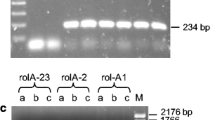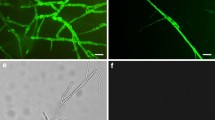Abstract
A nonpathogenic strain of Agrobacterium (=Rhizobium) vitis, ARK-1, limits the development of crown gall of grapevine (Vitis vinifera L.). Co-inoculation of grapevine shoots with ARK-1 and the tumorigenic (Ti) strain VAT03-9 at a 1:1 cell ratio resulted in significantly lower expression of the virulence genes virD2 and virE2 of VAT03-9 1 day after inoculation (dai) compared with expression levels when shoots were inoculated only with VAT03-9. In contrast, nonpathogenic A. vitis strain VAR06-30, which does not limit the development of crown gall of grapevine, co-inoculated with VAT03-9 did not affect expression levels of virD2 and virE2 under the same conditions. ARK-1 began to suppress the VAT03-9 population by seven dai, but no such effect was observed with VAR06-30 during the nine dai study period. Thus, the biological control activity of ARK-1 is likely based on the suppression of essential virulence genes.




Similar content being viewed by others
References
Burr, T. J., & Otten, L. (1999). Crown gall of grape: biology and disease management. Annual Review of Phytopathology, 37, 53–80.
Burr, T. J., & Reid, C. L. (1994). Biological control of grape crown gall with nontumorigenic Agrobacterium vitis F2/5. American Journal of Enology Viticulture, 45, 213–219.
Burr, T. J., Bazzi, C., Süle, S., & Otten, L. (1998). Crown gall of grape: biology of Agrobacterium vitis and the development of disease control strategies. Plant Disease, 82, 1288–1297.
Bustin, S. A., Benes, V., Garson, J. A., Hellemans, J., Huggett, J., Kubista, M., Mueller, R., Nolan, T., & Pfaffl, M. W. (2009). The MIQE guidelines: minimum information for publication of quantitative real-time PCR experiments. Clinical Chemistry, 55, 611–622.
Chen, F., Guo, Y. B., Wang, J. H., Li, J. Y., & Wang, H. M. (2007). Biological control of grape crown gall by Rahnella aquatilis HX2. Plant Disease, 91, 957–963.
Gelvin, S. B. (2012). Traversing the cell: Agrobacterium T-DNA’s journey to the host genome. Frontiers Plant Science, 3, 52. doi:10.3389/fpls.2012.00052.
Jones, H. D., Doherty, A., & Wu, H. (2005). Review of methodologies and a protocol for the Agrobacterium-mediated transformation of wheat. Plant Methods, 1, 5–11.
Kaewnum, S., Zheng, D., Reid, C. L., Johnson, K. L., Gee, J. C., & Burr, T. J. (2013). A host-specific biological control of grape crown gall by Agrobacterium vitis strain F2/5; its regulation and population dynamics. Phytopathology, 103, 427–435.
Kawaguchi, A. (2011). Genetic diversity of Rhizobium vitis strains in Japan based on multilocus sequence analysis using the sequences of pyrG, recA and rpoD. Journal of General Plant Pathology, 77, 299–303.
Kawaguchi, A. (2013). Biological control of crown gall on grapevine and root colonization by nonpathogenic Rhizobium vitis strain ARK-1. Microbes and Environments, 28, 306–311.
Kawaguchi, A. (2014). Reduction of pathogen populations at grapevine wound sites is associated with the mechanism of biological control of crown gall by Rhizobium vitis strain ARK-1. Microbes and Environments, 29, 296–302.
Kawaguchi, A., & Inoue, K. (2012). New antagonistic strains of non-pathogenic Agrobacterium vitis to control grapevine crown gall. Journal of Phytopathology, 160, 509–518.
Kawaguchi, A., Inoue, K., & Ichinose, Y. (2008). Biological control of crown gall of grapevine, rose, and tomato by nonpathogenic Agrobacterium vitis strain VAR03-1. Phytopathology, 98, 1218–1225.
Kawaguchi, A., Kondo, K., & Inoue, K. (2012). Biological control of apple crown gall by nonpathogenic Rhizobium vitis strain VAR03-1. Journal of General Plant Pathology, 78, 287–293.
Kerr, A. (1980). Biological control of crown gall through production of agrocin 84. Plant Disease, 64, 25–30.
Lacroix, B., & Citovsky, V. (2013). The roles of bacterial and host plant factors in Agrobacterium-mediated genetic transformation. The International Journal of Developmental Biology, 57, 467–481.
McCullen, C. A., & Binns, A. N. (2006). Agrobacterium tumefaciens and plant cell interactions and activities required for interkingdom macromolecular transfer. Annual Review of Cell and Developmental Biology, 22, 101–127.
Nester, E. W. (2015). Agrobacterium: nature’s genetic engineer. Frontiers Plant Science, 5, 730. doi:10.3389/ fpls.2014.00730.
Pfaffl, M. W., Horgan, G. W., & Dempfle, L. (2002). Relative expression software tool (REST) for group-wise comparison and statistical analysis of relative expression results in real-time PCR. Nucleic Acids Research, 30, e36.
Staphorst, J. L., van Zyl, F. G. H., Strijdom, B. W., & Groenewold, Z. E. (1985). Agrocin-producing pathogenic and nonpathogenic biotype-3 strains of Agrobacterium tumefaciens active against biotype-3 pathogens. Current Microbiology, 12, 45–52.
Vandesompele, J., De Preter, K., Pattyn, F., Poppe, B., Van Roy, N., De Paepe, A., & Speleman, F. (2002). Accurate normalization of real-time quantitative RT-PCR data by geometric averaging of multiple internal control genes. Genome Biology, 3, research0034.
Wang, H. M., Wang, H. X., Ng, T. B., & Li, J. Y. (2003). Purification and characterization of an antibacterial compound produced by Agrobacterium vitis strain E26 with activity against A. tumefaciens. Plant Pathology, 52, 134–143.
Young, J. M., Kerr, A., & Sawada, H. (2005). Genus II. Agrobacterium. In G. M. Garrity (Ed.), Bergey’s manual of systematic bacteriology (2nd ed., Vol. 2, pp. 340–345). New York: Springer Verlag.
Acknowledgments
This work was supported by a Japan Society for the Promotion of Science KAKENHI Grant (Number 2550038). I thank Associate Prof. Y. Noutoshi (Okayama University Okayama, Japan) for providing useful advice on experimental design.
Author information
Authors and Affiliations
Corresponding author
Electronic supplementary material
Below is the link to the electronic supplementary material.
Fig. S1
Stability of expression of four candidate reference genes in grapevine shoots. Stability values (M) for the four reference genes were evaluated with the geNorm algorithm (http://medgen.ugent.be/~jvdesomp/genorm/) in bacterial cells of the tumorigenic Agrobacterium vitis strain inoculated into shoots of the grapevine plant. In the plot, genes are ranked from the least (left) to the most (right) stable. The pyrG gene had the highest expression stability among the reference genes, and was chosen for use in the present study. However, the pairwise variations (V n /V n+1) did not show values (geNorm V ratio < 0.15) for the optimal number of reference genes (data not shown). (JPEG 80 kb)
Fig. S2
Amplification products of partial sequences of (a) virD2, (b) virE2, and (c) pyrG obtained by RT-qPCR separated by gel electrophoresis. Lanes: M, DNA ladder marker; 1, VAT03-9; 2, ARK-1 plus VAT03-9; 3, VAR06-30 plus VAT03-9; 4, ARK-1; 5, VAR06-30; 6, distilled water. The expected sizes of the RT-PCR products are 61-bp of virD2 (a), 59-bp of virE2 (b), and 69-bp of pyrG (c). (JPEG 170 kb)
Fig. S3
Illustration of the experimental design used to study of the population dynamics during coexistence of the nonpathogenic strains (ARK-1sc or VAR06-30sc) with the tumorigenic strain VAT03-9n in grapevine plants. (a) A 5-μL drop of the mixed cell suspension was dropped onto a needle-prick wound on the grapevine shoot. (b) Shoot samples that included the wound site were collected from 5 plants at each of eight times. (c) After washing and crushing the samples, ten-fold serial dilutions were plated onto St-CuSO4-PSA and nal-PSA media. hai, hours after inoculation; dai, days after inoculation. (JPEG 206 kb)
Rights and permissions
About this article
Cite this article
Kawaguchi, A. Biological control agent Agrobacterium vitis strain ARK-1 suppresses expression of the virD2 and virE2 genes in tumorigenic A. vitis . Eur J Plant Pathol 143, 789–799 (2015). https://doi.org/10.1007/s10658-015-0730-8
Accepted:
Published:
Issue Date:
DOI: https://doi.org/10.1007/s10658-015-0730-8




